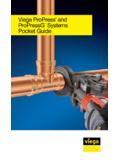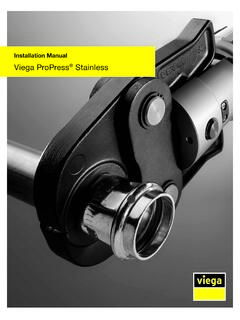Transcription of INSTALLATION & OPERATION INSTRUCTIONS FLOW …
1 INSTALLATION & OPERATION INSTRUCTIONS FLOW control . IMPORTANT NOTE! Please take the time to read this instruction sheet. Disregarding these guidelines may adversely affect your piping components GENERAL INFORMATION .. 1. O-RING REPLACEMENT .. 2. CLEANING .. 3. ALTERNATE FLUIDS .. 3. INSTALLATION GUIDELINES .. 3. Threaded Valves .. 3. Press Valves .. 3. Sweat Valves .. 3. Flanged Valves .. 4. Grooved End Valves .. 4. Weld End Valves .. 5. Actuator Operated Valves .. 5. Actuator Wiring Diagrams .. 6. Hoses .. 7. VERIFYING THE FLOWRATE .. 9. Automatic Flow Limiting Valves .. 9. Pressure Independent Valves .. 9. Manual Balance QuickSet & QuickDisc (See SpeedSet IOM for INSTRUCTIONS ).. 10. Manual Balance Valve Meter Kit .. 10. CARTRIDGE REMOVAL .. 11. Isolator R, Isolator Y, Automizer , K Valve, PIC-V , Uni-Flange .. 11. Threaded Mini, Combo Valve .. 11. Wafer, Grooved End, Flange End .. 11. BALL VALVE STEM 12. Handle Operated Stem.
2 12. Actuator Operated Stem (Non Direct Mount) .. 12. Actuator Operated Stem (Direct Mount) .. 13. REPLACING THE SEALS AND O RINGS .. 14. Unimizer (1/2 - 3 ) .. 14. Automizer/PIC 15. TROUBLE SHOOTING VALVES .. 15. WARRANTY .. 16. Griswold Controls assumes no responsibility for damages or injuries resulting from non-compliance with INSTALLATION INSTRUCTIONS or standard good practice when installing, operating, or maintaining the valves, even if not explicitly mentioned in the INSTALLATION INSTRUCTIONS . Griswold Controls uses many quality control checkpoints during its manufacturing process. Handling during transport, unpacking or INSTALLATION can alter a product's performance, including joint connections. If torque is applied to the product during INSTALLATION , dope will crack and a leak may occur. We rely on you as professional contractors to inspect, install and perform a thorough test during startup to correct any adverse handling or INSTALLATION conditions that may affect the performance of the product.
3 Thank you for your assistance. GENERAL INFORMATION. 1. Griswold Controls' valves MAY contain drain valves and/or combination P/T test valve and manual air vent (CPTA). You can identify the CPTA because the sticker on top says NO. TAPE DOPE Both types of accessory components have a straight thread and do not require any pipe dope or tape sealant. Using pipe dope or sealant may cause problems Drain CPTA. with the seal and may clog the hole in the housing that is used to vent air with the CPTA. Extensions for these components also have a straight thread. 1 12/20. This specification 2020 Griswold Controls F-709ZF. 1700 Barranca Parkway, Irvine, CA 92606. (949) 559-6000 Fax (949) 559-6088. INSTALLATION & OPERATION INSTRUCTIONS FLOW control . 2. Air should be eliminated from the system so the Griswold Controls flow control valves remain full of fluid during OPERATION . This will also protect the system from noise and vibration due to cavitation.
4 To eliminate the air from the system the Griswold Controls CPTA can be used. To remove the air back out the CPTA half a turn from the housing to vent air using a small wrench. WARNING: Do not back the CPTA out ALL the way when the system is pressurized. When you begin to see water come out the air hole in the housing, tighten the CPTA. If an extension is used the hole is in the extension piece and the CPTA can be backed out of the extension a half a turn to eliminate the air. A second wrench will be required to hold the extension in place while the CPTA is being rotated. Make sure to install the valve with the air vent hole on the top of the valve. If the CPTA needs to be tightened to prevent water leaking please back the CPTA out 1 full turn and then retighten the CPTA to hand tight and then use a wrench to tighten an additional turn. It may be necessary to install Automatic Airvents or an Air Separator for piping systems with entrained air.
5 3. Pressure Independent Valves: All PI valves trap air in the regulator section of the valve. If the air is not removed, one of the effects is a valve that may pulsate with a mild or violent shaking force. The normal process of bleeding air from a system will not remove this air because the air is trapped within a chamber. A. convenient way to bleed the air is to pressurize the system, cycle the valve closed, wait 10-15 seconds, then open it. For optimum air removal, PSID across the valve should be about 10 PSID during purging. This exhausts air out of the diaphragm chamber and into the pipe where it can later rise to a high point for extraction. In a building with several valves, it is most convenient to perform this from a central building automation control . If the building is not occupied it is acceptable to cycle all the valves at once as long as there is a method in place to keep the system pressure differential within the valve differential pressure range.
6 4. Pressure Independent Valves: PI valves contain a diaphragm flow regulator which should be protected against over pressurization during start up and testing because the diaphragm can be damaged if the PSID. across the valve exceeds the maximum published pressure differential. 5. Clean the lines upstream of the valve particles larger than 1/16" diameter (welding slag, pipe scale & other contaminants). Upstream INSTALLATION of a 20 mesh strainer is recommended. 6. Do not use boiler additives, chemicals which are petroleum based or contain mineral oil, hydrocarbons, azole compounds or ethylene glycol acetate. Compounds which can be used, with minimum 50% water dilution, are diethylene glycol, ethylene glycol, and propylene glycol. If installing these valves in an addition or retrofitting an existing building, do not assume that the fluid in the existing piping meets these criteria. 7. Flow control valves may be inserted in the pipe line either horizontally or vertically.
7 Straight sections of piping upstream and downstream of the valves are not necessary for proper OPERATION . Reducing bushings or flanges may be attached directly to flow control valves. Standard adapters are adequate for INSTALLATION of flow control valves. Please follow good piping practices, system design, and maintenance as outlined in ASHRAE. published standards. For example do not pipe valves after two consecutive elbows. 8. All styles of flow control valves are marked to show the direction of flow. WARNING: The flow arrow must point in the direction of flow for proper OPERATION . 9. Do not install valves at pump discharge. Minimum of 8 pipe diameters or 8 feet, whichever is longer, is required before the valve after pump discharge. 10. When pressure testing the system with compressed air do not exceed 100 psi air pressure. O-RING REPLACEMENT. Assembly must be made with care to protect the O-ring from damage during INSTALLATION .
8 Some of the more important features to ensure this are: Cleanliness is important for proper seal action and long O-ring life. Foreign particles like dirt, metal chips, etc. in the O-ring groove may cause leakage and can damage the O-ring thus reducing its life. Using silicon oil or grease lubricant at assembly helps protect the O-ring from damage by abrasion, pinching, or cutting. Do not use aerosol products or petroleum based lubricants. The lubricant should not excessively soften or harden. Depending on the application, the O-ring should be placed in the groove or stretched over threads. O-rings should not be twisted, forced or rolled over sharp corners, threads, or other sharp edges. 2 12/20. This specification 2020 Griswold Controls F-709ZF. 1700 Barranca Parkway, Irvine, CA 92606. (949) 559-6000 Fax (949) 559-6088. INSTALLATION & OPERATION INSTRUCTIONS FLOW control . Pipe dope or sealant should never be used on o-rings or in the o-ring groove even if the O-ring is used to seal brass components.
9 Using sealant on the o-ring will shorten the life of the O-ring. CLEANING. If the system experiences large amounts of pipe scale due to poor water conditions, as sometimes found in older systems, provisions should be made to keep the system clean. Proper water treatment is also recommended. Depending on the system, strainers should be cleaned annually. All Griswold valves with strainers can be blown down with a drain valve. If the strainer is very dirty then the cap can be removed for thorough cleaning of the strainer element. Please follow INSTRUCTIONS for lubricating the cap o-ring when reinstalling the strainer and cap. ALTERNATE FLUIDS. The OPERATION of the Griswold flow control valve is dependent on the characteristics of the flowing medium. It is therefore important that when ordering a valve, complete fluid specifications are included (if the fluid is anything other than 100% water, example: If the fluid is 50/50 ethylene glycol and water).
10 1. Specific Gravity Specific gravity is the most important attribute of a liquid used in a Flow control Valve. The specific gravities of fluids at temperatures other than 60 F are referenced to water at 60 F. Correction will need to be made for any fluid with a specific gravity other than 1. The flow control valves are available in specific flow rate increments. When the flow rate is corrected for specific gravity, it may fall in-between two available flow rates. We will supply a valve that is closest to the theoretically determined flow unless otherwise requested. 2. Viscosity & Temperature The viscosity of a fluid is dependent on the fluid temperature. For some fluids such as water, the viscosity change with temperature is immaterial. In other fluids the viscosity change with temperature is noticeable. For viscosity higher than 50 SSU specific gravity, fluid viscosity, and operating temperature must be specified.

